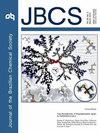Zn2Cr层状双氢氧化物的合成、表征及阴离子交换反应
IF 1.3
4区 化学
Q3 CHEMISTRY, MULTIDISCIPLINARY
引用次数: 1
摘要
采用增加pH共沉淀法合成了以Zn2Cr为主要成分的层状双氢氧化物(LDH),并通过x射线衍射(XRD)、傅里叶变换红外光谱(FTIR)、扫描电镜(SEM)、能谱分析(EDS)和电感耦合等离子体光学发射光谱(ICP-OES)对其进行了表征。在优化pH下合成的样品显示出层状结构的基底衍射峰,插层氯离子(Zn2Cr/Cl)和乙酸离子(Zn2Cr/Ac)的基底距离分别为7.88和12.69 Å。优化实验后,用不同的阴离子进行交换反应,用超过5倍的阴离子插入。Zn2Cr/Cl与CH3COO−、F−、Br−、I−、so4.2−和NO3−交换,Zn2Cr/Ac与F−、Cl−、Br−、I−、SO42−和NO3−交换。并不是所有的反应都是有效的,说明在评价的阴离子中,CH3COO−优先进行交换,这主要是由于与较大阴离子的预膨胀,有利于与较小阴离子的交换。本文章由计算机程序翻译,如有差异,请以英文原文为准。
Synthesis, Characterization, and Anion Exchange Reactions of Zn2Cr Layered Double Hydroxides Intercalated with Acetate and Chloride
Layered double hydroxides (LDH) with the composition Zn2Cr, intercalated with acetate and chloride ions were synthesized by co-precipitation with increasing pH and characterized by X-ray diffraction (XRD), Fourier-transform infrared spectroscopy (FTIR), scanning electron microscopy (SEM), energy dispersive spectroscopy (EDS) and inductively coupled plasma-optical emission spectrometry (ICP-OES). The samples synthesized at optimized pH showed XRD patterns with basal diffraction peaks typical of layered structures, with basal distances of 7.88 and 12.69 Å for intercalated chloride (Zn2Cr/Cl) and acetate (Zn2Cr/Ac), respectively. After optimization experiments, exchange reactions were performed with different anions, using an excess of five times the anions to be intercalated. Zn2Cr/Cl was exchanged with CH3COO−, F−, Br−, I−, SO4 2− and NO3−, and Zn2Cr/Ac was exchanged with F−, Cl−, Br−, I−, SO42− and NO3−. Not all reactions were effective, indicating that among the evaluated anions, CH3COO− was preferred for exchange, mainly attributed to the pre-expansion with bigger anions, facilitating the exchange with smaller anions.
求助全文
通过发布文献求助,成功后即可免费获取论文全文。
去求助
来源期刊
CiteScore
2.90
自引率
7.10%
发文量
99
审稿时长
3.4 months
期刊介绍:
The Journal of the Brazilian Chemical Society embraces all aspects of chemistry except education, philosophy and history of chemistry. It is a medium for reporting selected original and significant contributions to new chemical knowledge.

 求助内容:
求助内容: 应助结果提醒方式:
应助结果提醒方式:


